| (138 révisions intermédiaires par 3 utilisateurs non affichées) | |||
| Ligne 2 : | Ligne 2 : | ||
|Main_Picture=Bio_Charbon_Sechage Charbon Vert (c) Pierre Alain (GOB).JPG | |Main_Picture=Bio_Charbon_Sechage Charbon Vert (c) Pierre Alain (GOB).JPG | ||
|Licences=Attribution-ShareAlike (CC BY-SA) | |Licences=Attribution-ShareAlike (CC BY-SA) | ||
| − | |Description=Making | + | |Description=Making coal briquettes with carbonised agricultural waste. |
|Area=Food, Energy | |Area=Food, Energy | ||
|Type=Tutorial | |Type=Tutorial | ||
| Ligne 16 : | Ligne 16 : | ||
}} | }} | ||
{{Introduction | {{Introduction | ||
| − | |Introduction=Global Context | + | |Introduction='''Global Context''' |
| − | For several decades, Senegal suffers from the | + | For several decades, Senegal suffers from the high pressure on its natural resources, with 42% of the forest area in Senegal has disappeared since 1960. Strong demographic increase, abusive logging for fuel, non-lasting agricultural practices, and bush fires (350000 ha/an) are the principal causes. |
| − | Strong demographic increase, abusive logging for fuel, non-lasting agricultural practices and bush fires (350000 ha/an) are the | ||
Therefore, we assist in irregularities, lack of rain, as well as recurring droughts. | Therefore, we assist in irregularities, lack of rain, as well as recurring droughts. | ||
| − | Energy situation in Senegal | + | '''Energy situation in Senegal''' |
| − | In Senegal, 84% of | + | In Senegal, 84% of household fuel consumption comes from wood and charcoal. For example, every year, the population uses 58kg of coal per habitant. This consumption encourages logging and puts pressure on the natural resources of the country. |
| − | Advantages of Bio-Coal | + | '''Advantages of Bio-Coal''' |
The bio-coal, made from agricultural waste (such as straws, peanut shells, or even bush straws) can replace charcoal. | The bio-coal, made from agricultural waste (such as straws, peanut shells, or even bush straws) can replace charcoal. | ||
| − | Bio-coal can also offer | + | Bio-coal can also offer economic and social advantages on the ecological level: |
| − | + | In terms of the economic framework, although a light consumption of regular coal is necessary, bio-coal is more advantageous to family users. In the Kaolack region, the bio-coal sells for 150 CFA per kilo, whereas charcoal sells for 250 to 300 CFA per kilo.* (NEBEDAY association) | |
| − | + | In terms of the environmental framework, the development of bush straws and agricultural wastes as renewable biomasses decreases the risk of starting bush fires. And therefore strengthen the preservation of the forest and its biodiversity. | |
| − | + | Finally, charcoal made from straws is used under the same conditions as charcoal. Hence, it respects the local culinary traditions, which allows the local population to accept using bio-charcoal quicker. | |
| − | + | "This tutorial is produced in partner with the [http://www.nebeday.org Nebeday] association , who developed numerous programmes for the participative management of natural resources by and for the local population in Senegal." | |
}} | }} | ||
{{TutoVideo | {{TutoVideo | ||
| Ligne 46 : | Ligne 45 : | ||
}} | }} | ||
{{Materials | {{Materials | ||
| − | |Material=* | + | |Material=*Agricultural residue : straws |
| − | + | For 50 kilo of straws | |
| − | *100L | + | *100L water |
| − | * 5. | + | *5.5kg clay |
| − | * 15 kg | + | *15 kg crushed peanut shells |
| − | |Tools=* | + | |Tools=*200L metal barrel turned pyrolyzer (for carbonisation) |
| − | * | + | *Shovel |
| − | * | + | *Rake |
| − | * | + | *Mask and safety gloves |
| − | * | + | *Big container for mixing |
| − | * | + | *Tarpaulin |
| − | * | + | *Pestle |
| − | * | + | *Sieve |
| − | * | + | *Press machine |
| − | * | + | *Drying racks |
| − | * | + | *Metal mould for standardising the size of the briquettes |
|Tuto_Attachments={{Tuto Attachments | |Tuto_Attachments={{Tuto Attachments | ||
|Attachment=Bio_Charbon_Affiche_CharbonVert_FR.pdf | |Attachment=Bio_Charbon_Affiche_CharbonVert_FR.pdf | ||
| Ligne 69 : | Ligne 68 : | ||
{{Tuto Step | {{Tuto Step | ||
|Step_Title=Discussion | |Step_Title=Discussion | ||
| − | |Step_Content= | + | |Step_Content=Provide us with you remarks, ideas, experiences [http://lowtechlab.wikifab.org/index.php/Discussion:Bio_Charbon '''here'''] to help us improve this lowtech! |
}} | }} | ||
{{Tuto Step | {{Tuto Step | ||
| − | |Step_Title= | + | |Step_Title=How it works |
| − | |Step_Content= | + | |Step_Content=The most important stage in the making of bio-coal briquettes is 'Carbonisation'. |
| − | + | This process is usually done within a carbonisation machine. Here, it is done with the metal barrel. The driest biomasses are placed in the barrel and ignited so that it gradually reaches around 400 to 500°C. | |
| − | '''Attention :''' | + | '''Attention :''' The best carbonisation proceeding depends on the management of the oxygen supply in the system. It's the oxygen that allows combustion and energy-releasing reaction. However, if the supply of oxygen is too strong, it risks burning the raw materials in place of producing the desired coal. |
| − | '''1 -''' | + | '''1 -''' Ignition |
| − | '''2 -''' | + | '''2 -''' After igniting, the temperature will gradually rise to 100°C, where the humidity (around 10%) contained in the biomass evaporates. |
| − | + | The temperature will then rise to around 280°C. This phase is called endothermic reaction, where energy is needed to work. This energy is supplied by the complete combustion of a small part of the straws in the carbonisation machine. The dryer the straws, the less energy will be necessary. | |
| − | + | Once it passed 280°C, the pyrolyse phase starts. The straws decompose into coal, tar, and other elements. This is called the exothermic reaction, where energy is released. Therefore, it is necessary to limit the oxygen supply when closing the carbonisation machine to avoid total combustion of the straws. The unconstrained heat by the pyrolyse would raise the temperature to 400°C until all straws reduce to coal, tar, and other compounds. | |
| − | |||
| − | '''Attention :''' | + | '''Attention :''' the quality of coal obtained at 400°C is not optimal (65% pure carbon). A temperature of 500°C allows for better quality production of coal (around 85% of pure carbon). Therefore, the combustion of a part of the created coal is needed as an energy supply to raise the temperature to 500. The difficulty of carbonisation is therefore controlling the inflow of oxygen to ensure that the combustion of coal is kept as minimal as possible for the production of good quality coal. |
| − | |||
| − | + | "Experiments and attempts allow us to have a better understanding of this procedure to reach maximum productivity." | |
}} | }} | ||
{{Tuto Step | {{Tuto Step | ||
| − | |Step_Title= | + | |Step_Title=The Carbonisation Machine |
| − | |Step_Content='''1)''' | + | |Step_Content='''1)''' Open the trapdoor on one end (1) of the 200L metal barrel. |
| − | '''2)''' | + | '''2)''' Pierce a lot of holes on the other end (2). |
| − | '''3)''' | + | '''3)''' Make a removable cover with this end (2). |
| − | '''4)''' | + | '''4)''' Weld the foot and handle for manipulating the Carbonisation machine, with the removable end (2) being the base of the system during carbonisation. |
|Step_Picture_00=Bio_Charbon_Carbonisateur 1.PNG | |Step_Picture_00=Bio_Charbon_Carbonisateur 1.PNG | ||
|Step_Picture_01=Bio_Charbon_Carbonisateur 2.PNG | |Step_Picture_01=Bio_Charbon_Carbonisateur 2.PNG | ||
| Ligne 107 : | Ligne 104 : | ||
}} | }} | ||
{{Tuto Step | {{Tuto Step | ||
| − | |Step_Title= | + | |Step_Title=Gathering the straws |
| − | |Step_Content= | + | |Step_Content=Gather the straws in bushes or the field after harvest, depending on the availability. |
'''Attention''' | '''Attention''' | ||
| − | + | It is important to dry the straws under the sun after gathering. | |
}} | }} | ||
{{Tuto Step | {{Tuto Step | ||
| − | |Step_Title= | + | |Step_Title=Filling the Carbonisation Machine |
| − | |Step_Content='''1)''' | + | |Step_Content='''1)''' Place the carbonisation machine with the removable end facing upwards. |
| − | '''2)''' | + | '''2)''' Place a cylinder in the middle of the barrel. For example, a tool handle could be used for this step. |
| − | ''' | + | '''Remark''' |
| − | + | The hole in the middle, made with a cylinder, will start the system. | |
| − | '''3)''' | + | '''3)''' Fill the straws, making sure it is pressed down. |
| − | '''4)''' | + | '''4)''' Pull out the cylinder |
| − | '''5)''' | + | '''5)''' Reposition the removable cover, making sure that it is well covered. |
|Step_Picture_00=Bio_Charbon_3 charger paille.PNG | |Step_Picture_00=Bio_Charbon_3 charger paille.PNG | ||
|Step_Picture_01=Bio_Charbon_4 charger paille 4.PNG | |Step_Picture_01=Bio_Charbon_4 charger paille 4.PNG | ||
| Ligne 132 : | Ligne 129 : | ||
}} | }} | ||
{{Tuto Step | {{Tuto Step | ||
| − | |Step_Title= | + | |Step_Title=Ignition |
| − | |Step_Content='''1)''' | + | |Step_Content='''1)''' Turn the carbonisation machine over with the end with the open trapdoor should be facing upwards. |
| − | '''2)''' | + | '''2)''' With the help of a rake, remove a bowl of soil with a diameter slightly larger than the carbonisation machine. Keep a ring of soil all around. |
| − | '''3)''' | + | '''3)''' Position the barrel in the centre of the ring. The air should be able to circulate under the carbonisation machine. |
| − | '''Attention''' | + | '''Attention''' Before igniting, make sure the work area is outdoors and well ventilated. The process releases smoke and gas. |
| − | '''4)''' | + | '''4)''' Light up the straw by the trapdoor and leave it open. |
|Step_Picture_00=Bio_Charbon_1 allumage.PNG | |Step_Picture_00=Bio_Charbon_1 allumage.PNG | ||
|Step_Picture_01=Bio_Charbon_2 allumage.PNG | |Step_Picture_01=Bio_Charbon_2 allumage.PNG | ||
| Ligne 149 : | Ligne 146 : | ||
{{Tuto Step | {{Tuto Step | ||
|Step_Title=Carbonisation | |Step_Title=Carbonisation | ||
| − | |Step_Content='''1)''' | + | |Step_Content='''1)''' Leave the straw to burn for around 30 minutes until the flames become clearer, with less visible smoke. |
| − | '''2)''' | + | '''2)''' Close the trapdoor |
| − | '''3)''' | + | '''3)''' Seal the trapdoor with moist soil to stop the inflow of oxygen. |
| − | '''4)''' | + | '''4)''' Move the soil back under the bottom of the barrel to stop the oxygen from entering the base. |
| − | '''5)''' | + | '''5)''' Leave it closed for 15 minutes. |
|Step_Picture_00=Bio_Charbon_carbonisation 1.PNG | |Step_Picture_00=Bio_Charbon_carbonisation 1.PNG | ||
|Step_Picture_01=Bio_Charbon_carbonisation 2.PNG | |Step_Picture_01=Bio_Charbon_carbonisation 2.PNG | ||
| Ligne 164 : | Ligne 161 : | ||
}} | }} | ||
{{Tuto Step | {{Tuto Step | ||
| − | |Step_Title= | + | |Step_Title=First mixture |
| − | |Step_Content='''1)''' | + | |Step_Content='''1)''' Open the carbonisation machine and empty it in a container. |
| − | '''Attention''' | + | '''Attention''' Work with safety gloves and goggles at all times, the barrel is extremely hot. |
| − | '''2)''' | + | '''2)''' For 20kg of carbonised material (coal-dust), add 20L of water and 4 kilos of clay. |
| − | '''3)''' | + | '''3)''' Mix well with a rake. |
| − | '''4)''' | + | '''4)''' Gather the mixture and drain properly. |
| − | '''5)''' | + | '''5)''' Spread the mixture across the drying rack to dry it under the sun. |
| − | '''6)''' | + | '''6)''' Store the dried coal dust in a cool and dry place. |
|Step_Picture_00=Bio_Charbon_premier melange 1.PNG | |Step_Picture_00=Bio_Charbon_premier melange 1.PNG | ||
|Step_Picture_01=Bio_Charbon_premier melange 2.PNG | |Step_Picture_01=Bio_Charbon_premier melange 2.PNG | ||
| Ligne 185 : | Ligne 182 : | ||
}} | }} | ||
{{Tuto Step | {{Tuto Step | ||
| − | |Step_Title= | + | |Step_Title=Second mixture |
| − | |Step_Content= | + | |Step_Content=The coal dust itself can not be used for making briquettes. It is necessary to apply a second mixture: |
| − | '''1)''' | + | '''1)''' Spread the tarpaulin on the ground. |
| − | '''2)''' | + | '''2)''' On the tarpaulin, prepare 50kg of dried coal dust from the previous mixture. |
| − | '''3)''' | + | '''3)''' For 50kg of coal-dust weigh and prepare 15kg of crushed peanut shells. |
| − | '''4)''' | + | '''4)''' Weigh and prepare 1.5kg of crushed and sieved clay. |
| − | ''' | + | '''Remark 1''' The crushed peanut shells, non-carbonised, allows the briquettes to be stronger, especially when burning. The clay serves as the binder. |
| − | '''5)''' | + | '''5)''' Incorporate the clay in the peanut shells, making sure to homogenise the mixture |
| − | ''' | + | '''Remark 2''' To fully blend the mixture of clay, peanut shells, and coal dust, spread one of the ingredients out on the ground and place the second one over it. With the help of a shovel, fold the mixture with little shovelfuls. First towards the outside, then towards the inside. |
| − | '''6)''' | + | '''6)''' Incorporate the clay/peanut mixture to the coal dust, making sure to homogenise the mixture. |
| − | '''7)''' | + | '''7)''' Place the mixture in a container and add 50L of water while mixing. |
| − | '''8)''' | + | '''8)''' Testing the proportion of the mixture: Make a ball with your hands and release it 1m above the ground. The ball should hold. If it breaks, there isn't enough water. If it is crushed, there is too much water. |
|Step_Picture_00=Bio_Charbon_deuxieme melange 1.PNG | |Step_Picture_00=Bio_Charbon_deuxieme melange 1.PNG | ||
|Step_Picture_01=Bio_Charbon_deuxieme melange 2.PNG | |Step_Picture_01=Bio_Charbon_deuxieme melange 2.PNG | ||
| Ligne 215 : | Ligne 212 : | ||
}} | }} | ||
{{Tuto Step | {{Tuto Step | ||
| − | |Step_Title= | + | |Step_Title=Pressing |
| − | |Step_Content=''' | + | |Step_Content='''Remark'''Several presses exists. Some are more accessible while others are more complex and expensive. The "worm screw press" used in this tutorial is the latter. This press has a real advantage with its access to electricity. Otherwise, some simpler manual press is preferable for reducing the difficulty of the work. |
| − | '''1)''' | + | '''1)''' Once the press is in action, insert the mixture in as you go. |
| − | '''2)''' | + | '''2)''' Extrude the briquettes at the desired length (which is 20cm here). |
| − | '''3)''' | + | '''3)''' Place the briquettes on the drying racks. |
| − | '''4)''' | + | '''4)''' with the help of the mould, cut the edges of the briquettes for standardising to the desired length. |
| − | '''Attention''' | + | '''Attention''' When using the "worm screw press", it is necessary to pay particular attention for safety reasons when supplying the mixture. |
| − | + | ||
| + | At least 2 people need to be present to be efficient. One person should be responsible for supplying and the other person should be responsible for the briquettes. | ||
}} | }} | ||
{{Tuto Step | {{Tuto Step | ||
| − | |Step_Title= | + | |Step_Title=Drying and Packing |
| − | |Step_Content='''1)''' | + | |Step_Content='''1)''' Place the racks under the sun for 3 to 4 days to dry the briquettes. |
| − | '''2)''' | + | '''2)''' Pack the briquettes for storage and sales. |
| − | '''Attention''' | + | '''Attention''' Make sure the briquettes are well protected in case of rain. |
| − | ''' | + | '''Remark''' Here, the briquettes are packed 2 by 2 in bags of revalued cement. |
}} | }} | ||
{{Tuto Step | {{Tuto Step | ||
| − | |Step_Title= | + | |Step_Title=Educational content to download |
| − | |Step_Content= | + | |Step_Content=You can download an educational file created by Low-tech lab in the "files" tab of the tutorial (tab under the section Tools & Materials) |
|Step_Picture_00=Bio_Charbon_charbon.JPG | |Step_Picture_00=Bio_Charbon_charbon.JPG | ||
}} | }} | ||
{{Notes | {{Notes | ||
| − | |Notes=* | + | |Notes=*NEBEDAY association: www.nebeday.org |
| − | * FAO: www.fao.org | + | *FAO: www.fao.org |
| + | |||
| + | Watch the video [https://www.youtube.com/watch?v=9-vJ9S3iRJM Arte Future - Cap sur l'innovation]. | ||
| − | + | Feel free to comment, share, and enhance the tutorial information useful for its improvement. | |
| − | + | Thank you to Emily Ngai for the English translation ! | |
| − | + | Thank you to Viridiana Arenas for the Spanish translation ! | |
}} | }} | ||
{{PageLang | {{PageLang | ||
Version actuelle datée du 25 mai 2021 à 12:18
Description
Making coal briquettes with carbonised agricultural waste.
Sommaire
Sommaire
- 1 Description
- 2 Sommaire
- 3 Introduction
- 4 Video d'introduction
- 5 Étape 1 - Discussion
- 6 Étape 2 - How it works
- 7 Étape 3 - The Carbonisation Machine
- 8 Étape 4 - Gathering the straws
- 9 Étape 5 - Filling the Carbonisation Machine
- 10 Étape 6 - Ignition
- 11 Étape 7 - Carbonisation
- 12 Étape 8 - First mixture
- 13 Étape 9 - Second mixture
- 14 Étape 10 - Pressing
- 15 Étape 11 - Drying and Packing
- 16 Étape 12 - Educational content to download
- 17 Notes et références
- 18 Commentaires
Introduction
Global Context
For several decades, Senegal suffers from the high pressure on its natural resources, with 42% of the forest area in Senegal has disappeared since 1960. Strong demographic increase, abusive logging for fuel, non-lasting agricultural practices, and bush fires (350000 ha/an) are the principal causes.
Therefore, we assist in irregularities, lack of rain, as well as recurring droughts.
Energy situation in Senegal
In Senegal, 84% of household fuel consumption comes from wood and charcoal. For example, every year, the population uses 58kg of coal per habitant. This consumption encourages logging and puts pressure on the natural resources of the country.
Advantages of Bio-Coal
The bio-coal, made from agricultural waste (such as straws, peanut shells, or even bush straws) can replace charcoal.
Bio-coal can also offer economic and social advantages on the ecological level:
In terms of the economic framework, although a light consumption of regular coal is necessary, bio-coal is more advantageous to family users. In the Kaolack region, the bio-coal sells for 150 CFA per kilo, whereas charcoal sells for 250 to 300 CFA per kilo.* (NEBEDAY association)
In terms of the environmental framework, the development of bush straws and agricultural wastes as renewable biomasses decreases the risk of starting bush fires. And therefore strengthen the preservation of the forest and its biodiversity.
Finally, charcoal made from straws is used under the same conditions as charcoal. Hence, it respects the local culinary traditions, which allows the local population to accept using bio-charcoal quicker.
"This tutorial is produced in partner with the Nebeday association , who developed numerous programmes for the participative management of natural resources by and for the local population in Senegal."Youtube
Matériaux
- Agricultural residue : straws
For 50 kilo of straws
- 100L water
- 5.5kg clay
- 15 kg crushed peanut shells
Outils
- 200L metal barrel turned pyrolyzer (for carbonisation)
- Shovel
- Rake
- Mask and safety gloves
- Big container for mixing
- Tarpaulin
- Pestle
- Sieve
- Press machine
- Drying racks
- Metal mould for standardising the size of the briquettes
Étape 1 - Discussion
Provide us with you remarks, ideas, experiences here to help us improve this lowtech!
Étape 2 - How it works
The most important stage in the making of bio-coal briquettes is 'Carbonisation'.
This process is usually done within a carbonisation machine. Here, it is done with the metal barrel. The driest biomasses are placed in the barrel and ignited so that it gradually reaches around 400 to 500°C.
Attention : The best carbonisation proceeding depends on the management of the oxygen supply in the system. It's the oxygen that allows combustion and energy-releasing reaction. However, if the supply of oxygen is too strong, it risks burning the raw materials in place of producing the desired coal.
1 - Ignition
2 - After igniting, the temperature will gradually rise to 100°C, where the humidity (around 10%) contained in the biomass evaporates.
The temperature will then rise to around 280°C. This phase is called endothermic reaction, where energy is needed to work. This energy is supplied by the complete combustion of a small part of the straws in the carbonisation machine. The dryer the straws, the less energy will be necessary.
Once it passed 280°C, the pyrolyse phase starts. The straws decompose into coal, tar, and other elements. This is called the exothermic reaction, where energy is released. Therefore, it is necessary to limit the oxygen supply when closing the carbonisation machine to avoid total combustion of the straws. The unconstrained heat by the pyrolyse would raise the temperature to 400°C until all straws reduce to coal, tar, and other compounds.
Attention : the quality of coal obtained at 400°C is not optimal (65% pure carbon). A temperature of 500°C allows for better quality production of coal (around 85% of pure carbon). Therefore, the combustion of a part of the created coal is needed as an energy supply to raise the temperature to 500. The difficulty of carbonisation is therefore controlling the inflow of oxygen to ensure that the combustion of coal is kept as minimal as possible for the production of good quality coal.
"Experiments and attempts allow us to have a better understanding of this procedure to reach maximum productivity."
Étape 3 - The Carbonisation Machine
1) Open the trapdoor on one end (1) of the 200L metal barrel.
2) Pierce a lot of holes on the other end (2).
3) Make a removable cover with this end (2).
4) Weld the foot and handle for manipulating the Carbonisation machine, with the removable end (2) being the base of the system during carbonisation.
Étape 4 - Gathering the straws
Gather the straws in bushes or the field after harvest, depending on the availability.
Attention It is important to dry the straws under the sun after gathering.
Étape 5 - Filling the Carbonisation Machine
1) Place the carbonisation machine with the removable end facing upwards.
2) Place a cylinder in the middle of the barrel. For example, a tool handle could be used for this step.
Remark The hole in the middle, made with a cylinder, will start the system.
3) Fill the straws, making sure it is pressed down.
4) Pull out the cylinder
5) Reposition the removable cover, making sure that it is well covered.
Étape 6 - Ignition
1) Turn the carbonisation machine over with the end with the open trapdoor should be facing upwards.
2) With the help of a rake, remove a bowl of soil with a diameter slightly larger than the carbonisation machine. Keep a ring of soil all around.
3) Position the barrel in the centre of the ring. The air should be able to circulate under the carbonisation machine.
Attention Before igniting, make sure the work area is outdoors and well ventilated. The process releases smoke and gas.
4) Light up the straw by the trapdoor and leave it open.
Étape 7 - Carbonisation
1) Leave the straw to burn for around 30 minutes until the flames become clearer, with less visible smoke.
2) Close the trapdoor
3) Seal the trapdoor with moist soil to stop the inflow of oxygen.
4) Move the soil back under the bottom of the barrel to stop the oxygen from entering the base.
5) Leave it closed for 15 minutes.
Étape 8 - First mixture
1) Open the carbonisation machine and empty it in a container.
Attention Work with safety gloves and goggles at all times, the barrel is extremely hot.
2) For 20kg of carbonised material (coal-dust), add 20L of water and 4 kilos of clay.
3) Mix well with a rake.
4) Gather the mixture and drain properly.
5) Spread the mixture across the drying rack to dry it under the sun.
6) Store the dried coal dust in a cool and dry place.
Étape 9 - Second mixture
The coal dust itself can not be used for making briquettes. It is necessary to apply a second mixture:
1) Spread the tarpaulin on the ground.
2) On the tarpaulin, prepare 50kg of dried coal dust from the previous mixture.
3) For 50kg of coal-dust weigh and prepare 15kg of crushed peanut shells.
4) Weigh and prepare 1.5kg of crushed and sieved clay.
Remark 1 The crushed peanut shells, non-carbonised, allows the briquettes to be stronger, especially when burning. The clay serves as the binder.
5) Incorporate the clay in the peanut shells, making sure to homogenise the mixture
Remark 2 To fully blend the mixture of clay, peanut shells, and coal dust, spread one of the ingredients out on the ground and place the second one over it. With the help of a shovel, fold the mixture with little shovelfuls. First towards the outside, then towards the inside.
6) Incorporate the clay/peanut mixture to the coal dust, making sure to homogenise the mixture.
7) Place the mixture in a container and add 50L of water while mixing.
8) Testing the proportion of the mixture: Make a ball with your hands and release it 1m above the ground. The ball should hold. If it breaks, there isn't enough water. If it is crushed, there is too much water.
Étape 10 - Pressing
RemarkSeveral presses exists. Some are more accessible while others are more complex and expensive. The "worm screw press" used in this tutorial is the latter. This press has a real advantage with its access to electricity. Otherwise, some simpler manual press is preferable for reducing the difficulty of the work.
1) Once the press is in action, insert the mixture in as you go.
2) Extrude the briquettes at the desired length (which is 20cm here).
3) Place the briquettes on the drying racks.
4) with the help of the mould, cut the edges of the briquettes for standardising to the desired length.
Attention When using the "worm screw press", it is necessary to pay particular attention for safety reasons when supplying the mixture.
At least 2 people need to be present to be efficient. One person should be responsible for supplying and the other person should be responsible for the briquettes.
Étape 11 - Drying and Packing
1) Place the racks under the sun for 3 to 4 days to dry the briquettes.
2) Pack the briquettes for storage and sales.
Attention Make sure the briquettes are well protected in case of rain.
Remark Here, the briquettes are packed 2 by 2 in bags of revalued cement.
Étape 12 - Educational content to download
You can download an educational file created by Low-tech lab in the "files" tab of the tutorial (tab under the section Tools & Materials)
Notes et références
- NEBEDAY association: www.nebeday.org
- FAO: www.fao.org
Watch the video Arte Future - Cap sur l'innovation.
Feel free to comment, share, and enhance the tutorial information useful for its improvement.
Thank you to Emily Ngai for the English translation !
Thank you to Viridiana Arenas for the Spanish translation !
Published
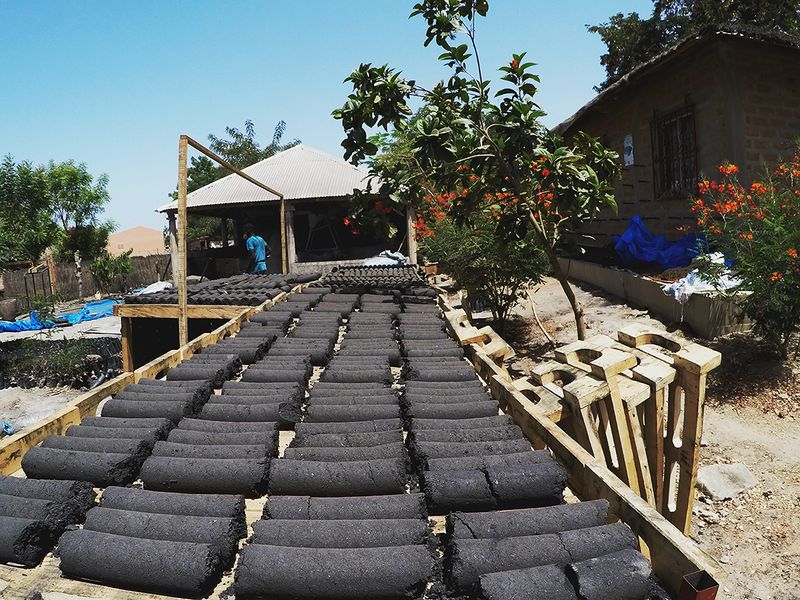
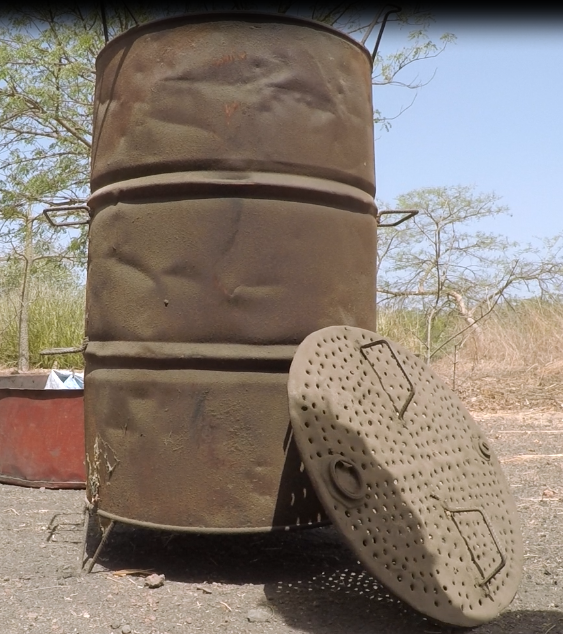
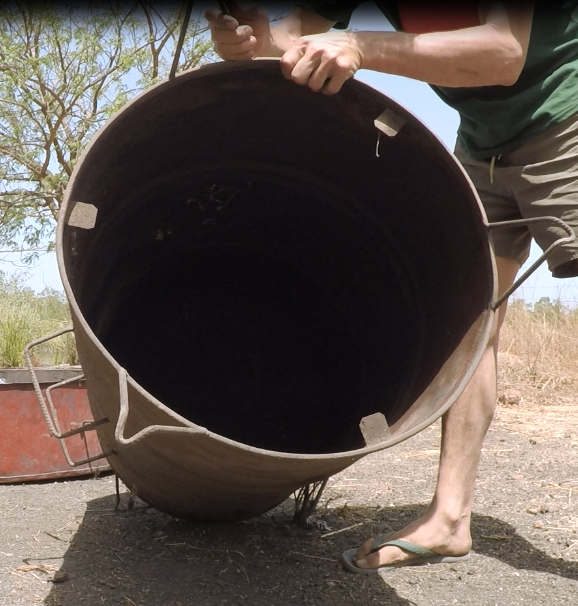
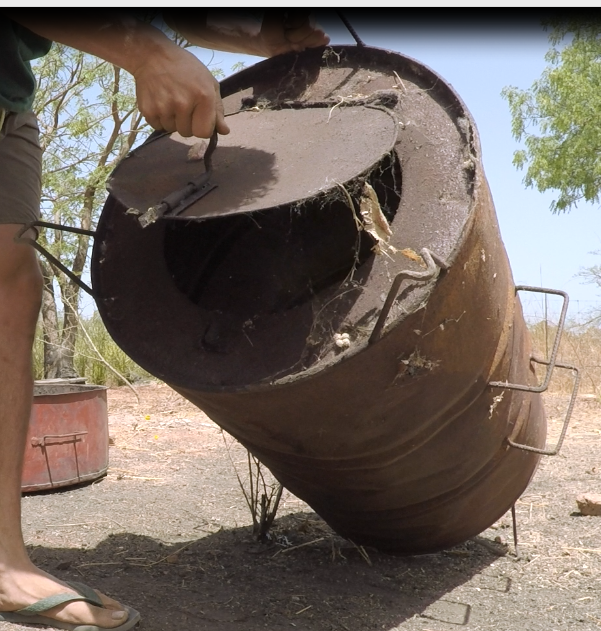
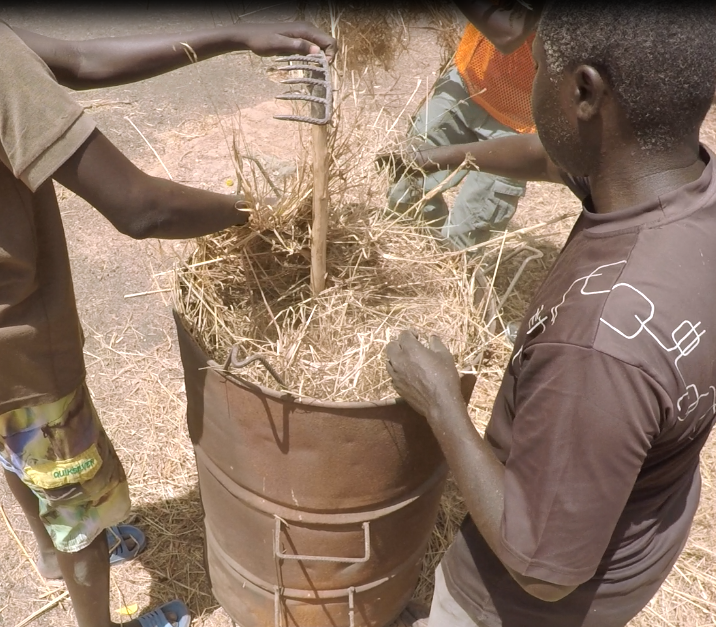
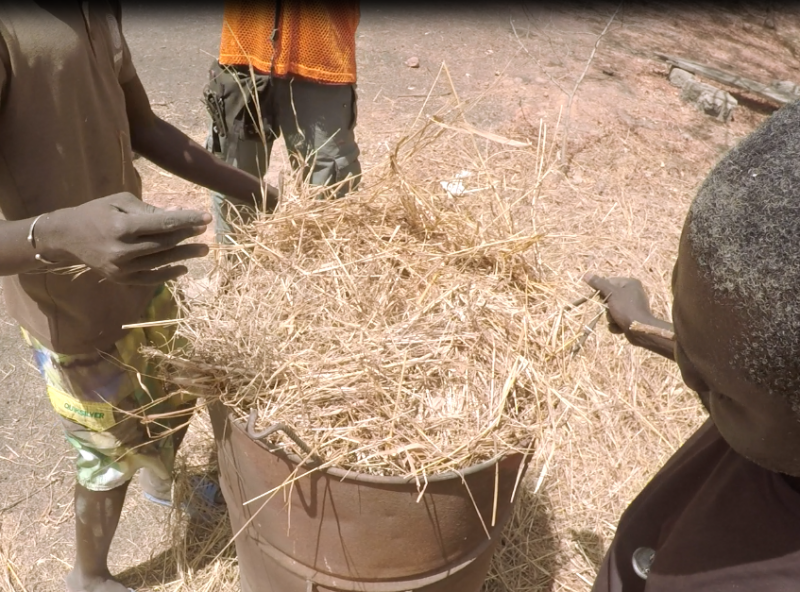
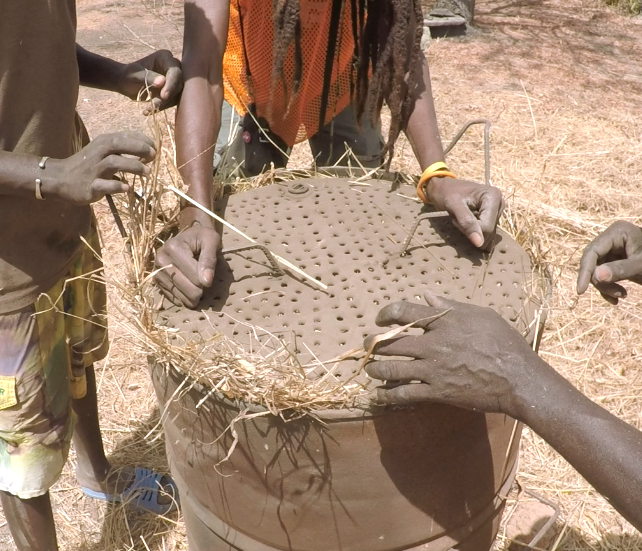
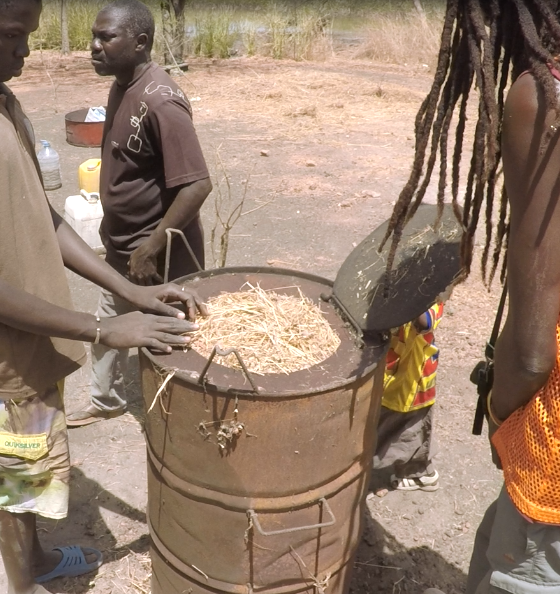
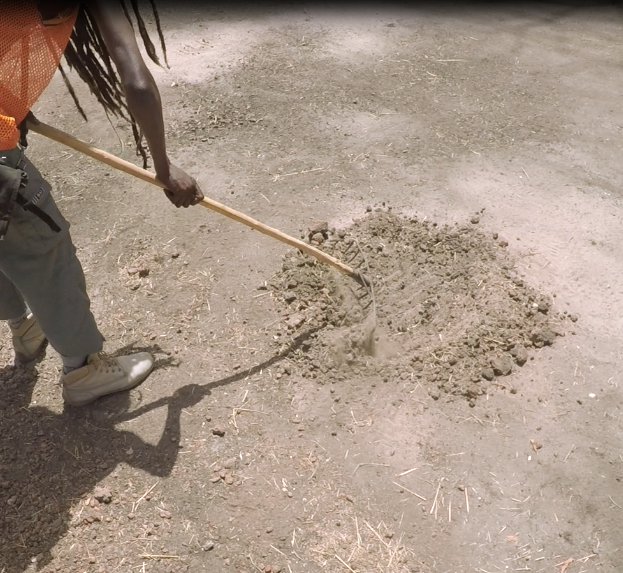
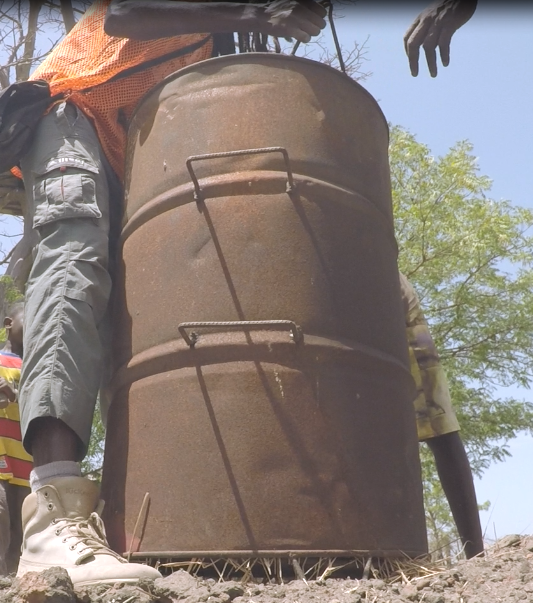
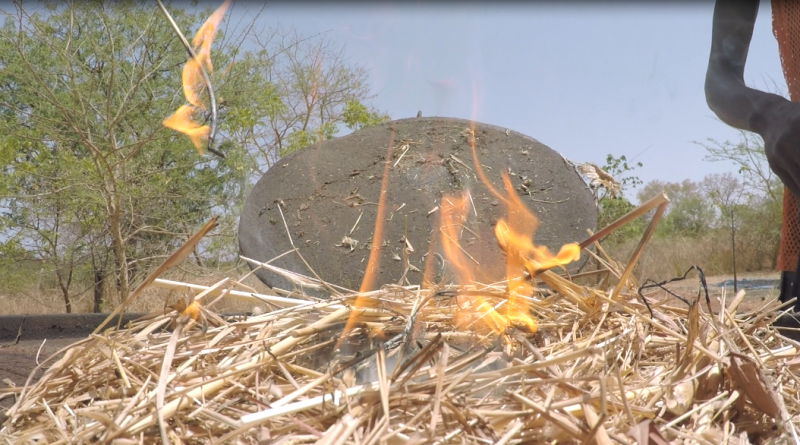
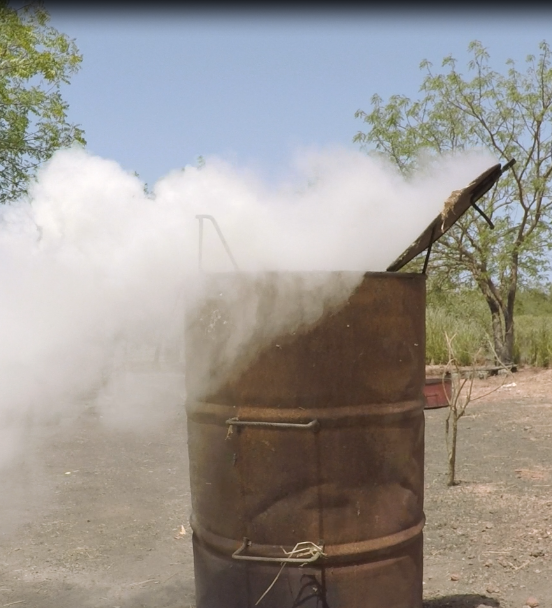
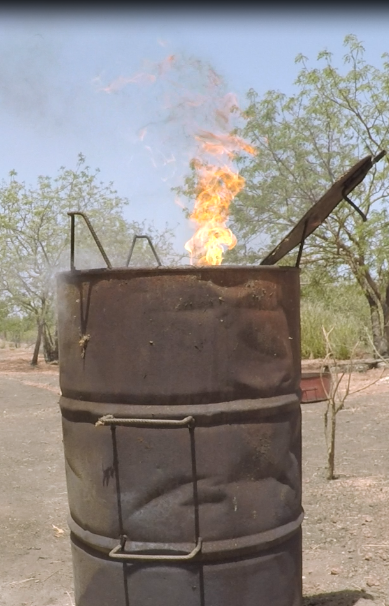
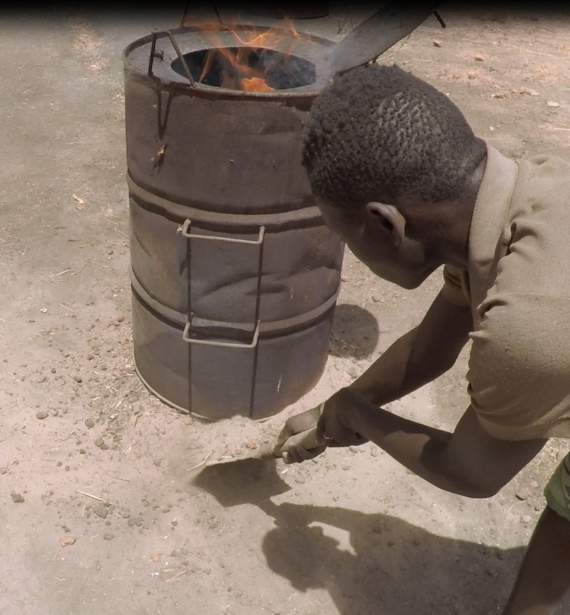
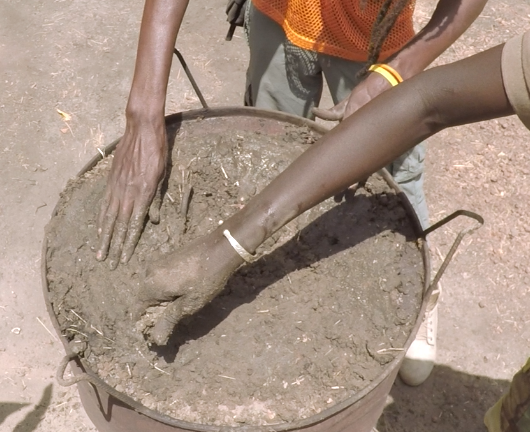
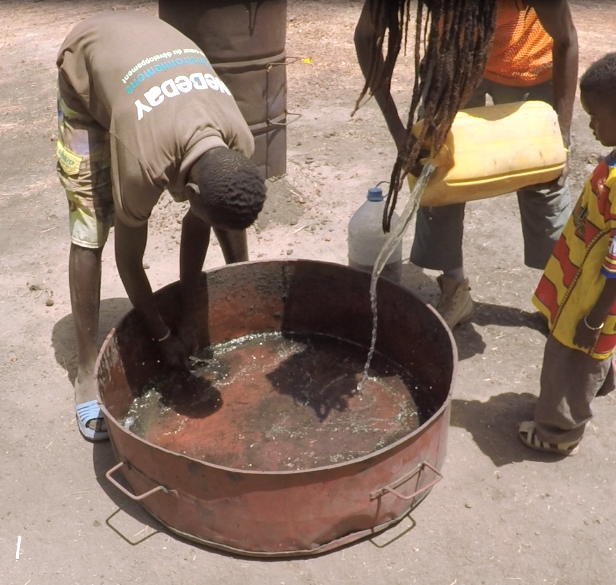
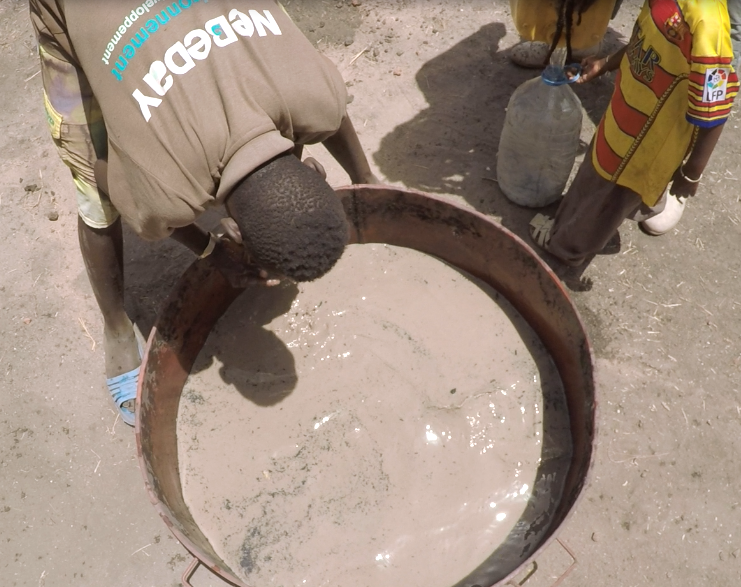
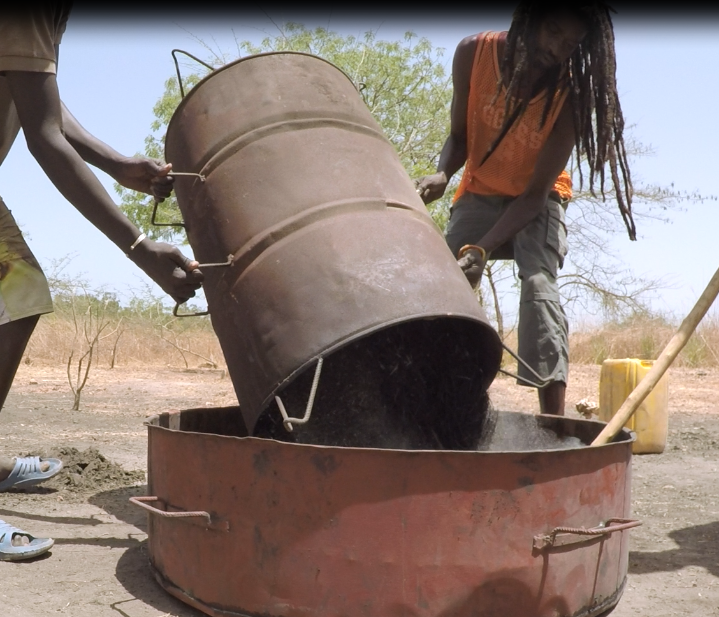
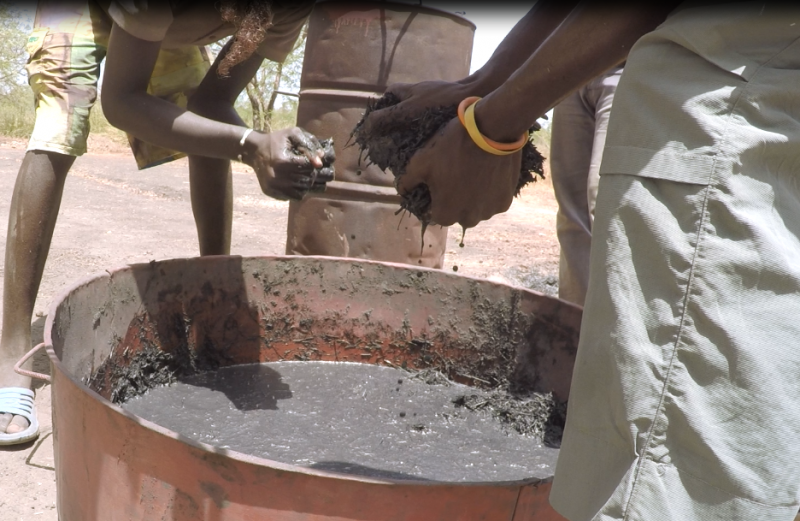
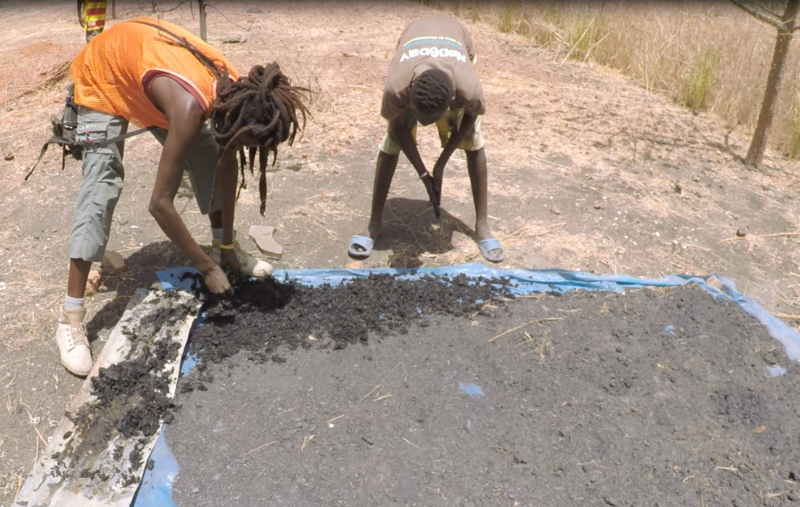
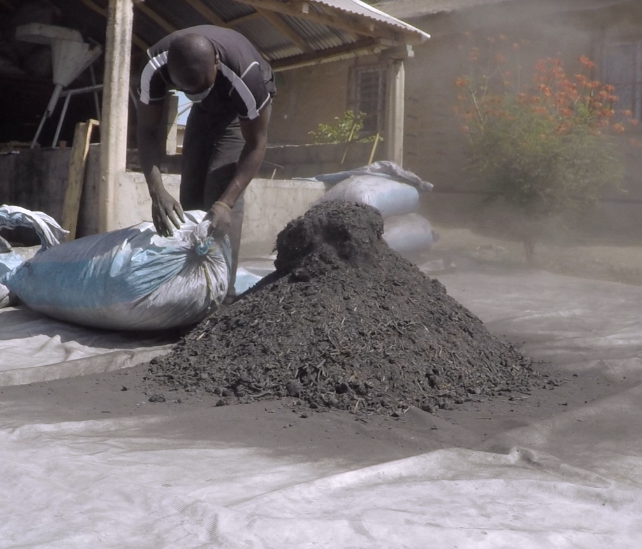
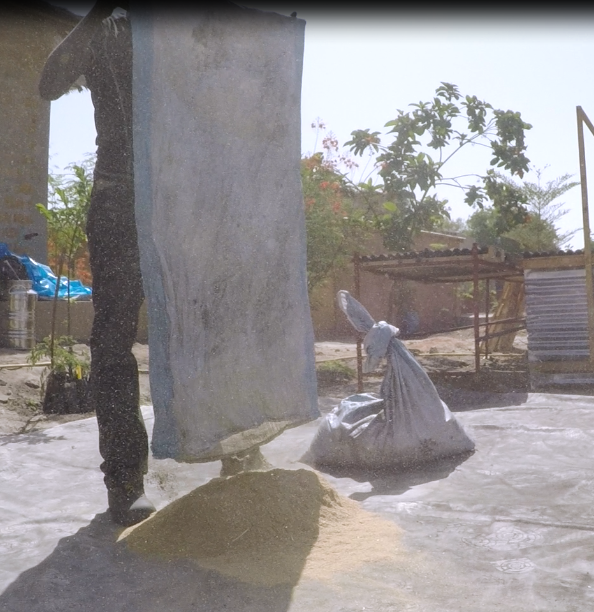
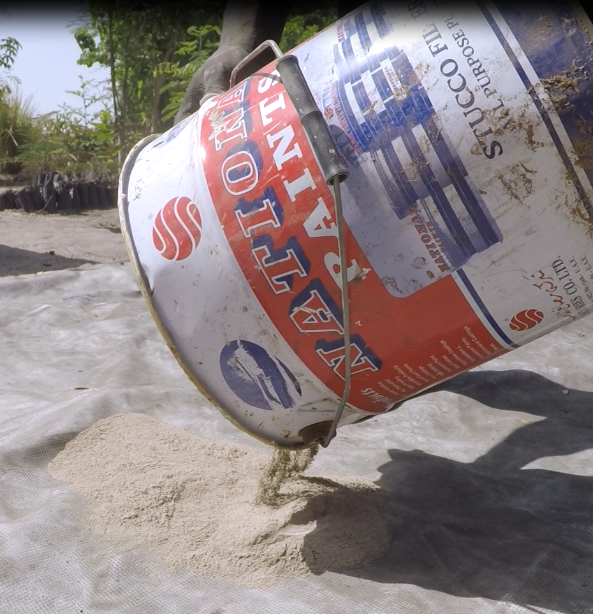
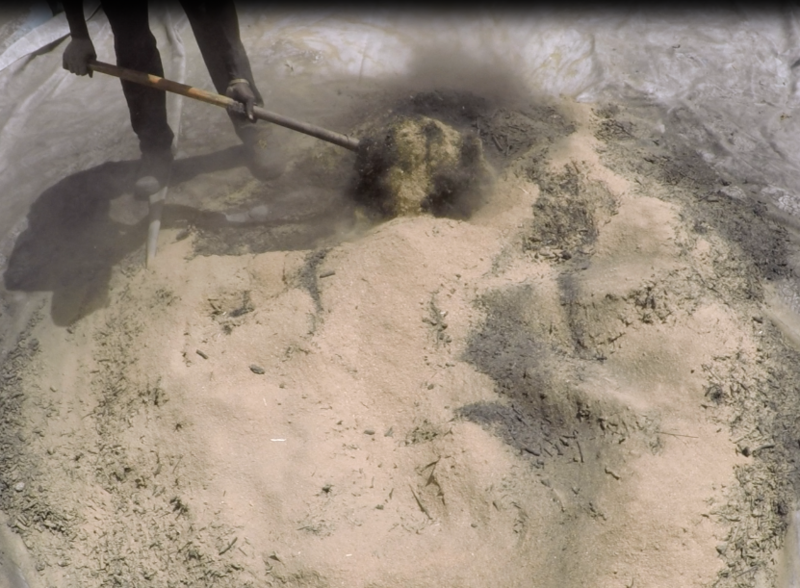
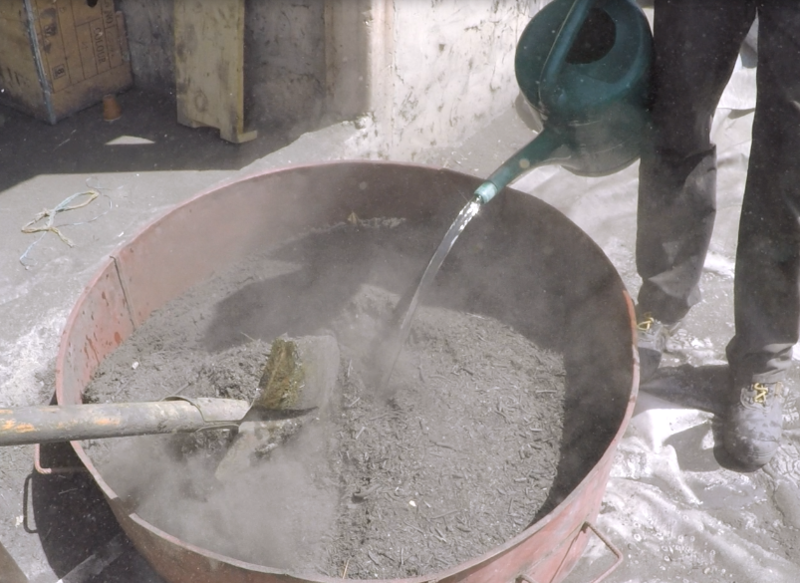
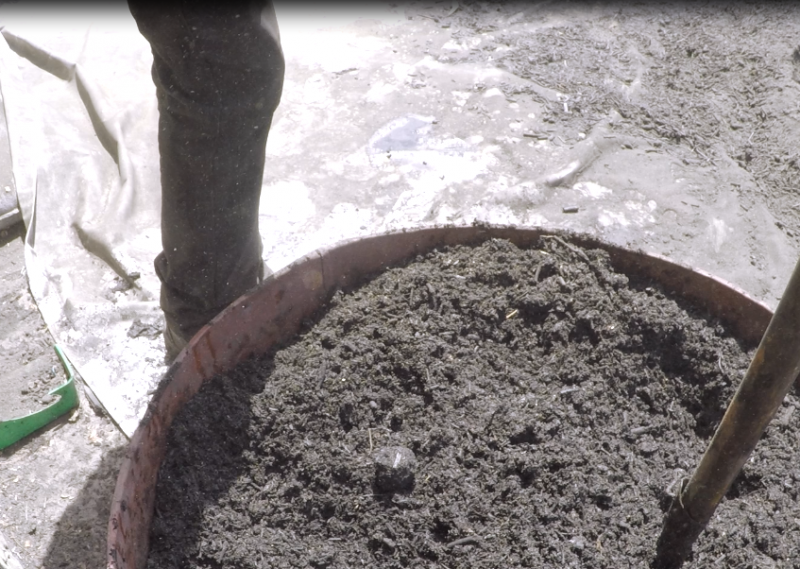
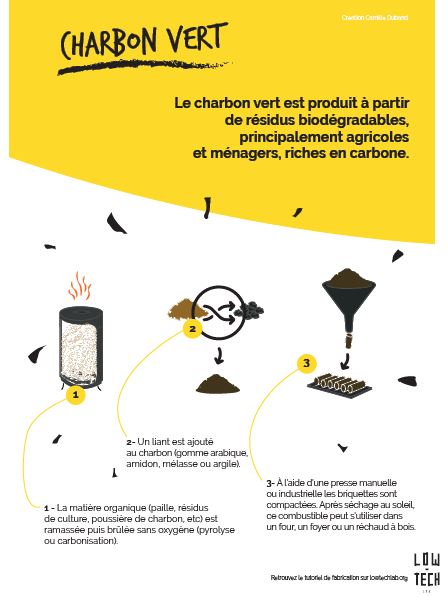
 Français
Français English
English Deutsch
Deutsch Español
Español Italiano
Italiano Português
Português